Incomplete Dominance in Tay-Sachs Disease: A BIOL0003 Genetics Essay
VerifiedAdded on 2022/08/12
|8
|1512
|20
Essay
AI Summary
This essay examines incomplete dominance, using Tay-Sachs disease as a prominent example. It defines dominance and introduces Tay-Sachs as a genetic disorder affecting nerve cells. The discussion delves into the disease's symptoms, prevalence in specific ethnic groups, and autosomal recessive inheritance pattern. The essay explores the genetic mechanism, highlighting the role of the HEX-A gene and the deficiency of hexosaminidase A, which leads to the accumulation of GM2 ganglioside. It explains how mutations in the HEX-A gene disrupt enzyme activity, leading to the disease. Furthermore, the essay discusses the genetic inheritance, including compound heterozygosis and the probabilities of disease occurrence in offspring. The essay concludes by summarizing incomplete dominance and the key genetic aspects of Tay-Sachs disease, including the role of the HEX-A gene and the importance of enzymatic activity.

Running head: INCOMPLETE DOMINANCE
INCOMPLETE DOMINANCE
Name of the student:
Name of the university:
Author note:
INCOMPLETE DOMINANCE
Name of the student:
Name of the university:
Author note:
Paraphrase This Document
Need a fresh take? Get an instant paraphrase of this document with our AI Paraphraser
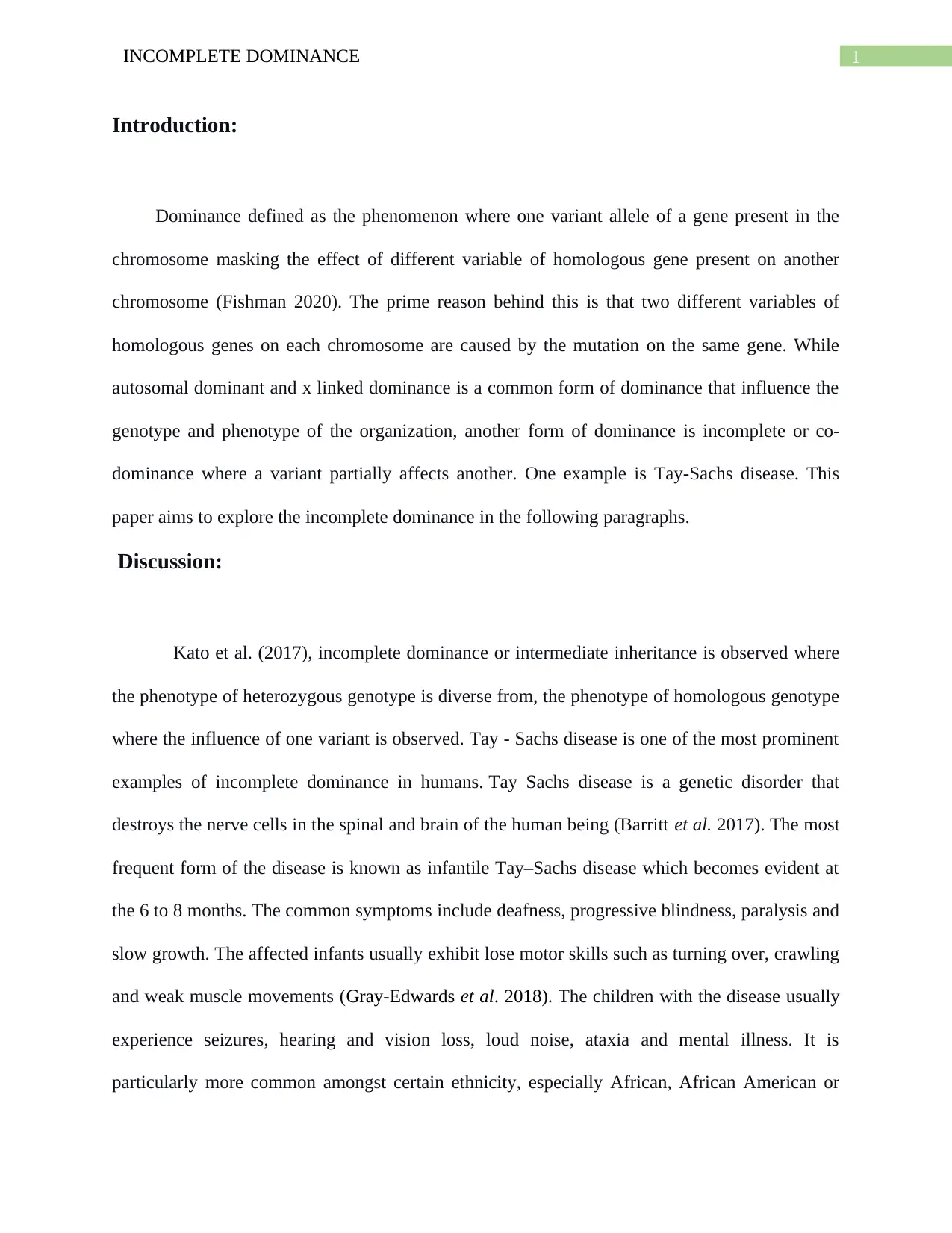
1INCOMPLETE DOMINANCE
Introduction:
Dominance defined as the phenomenon where one variant allele of a gene present in the
chromosome masking the effect of different variable of homologous gene present on another
chromosome (Fishman 2020). The prime reason behind this is that two different variables of
homologous genes on each chromosome are caused by the mutation on the same gene. While
autosomal dominant and x linked dominance is a common form of dominance that influence the
genotype and phenotype of the organization, another form of dominance is incomplete or co-
dominance where a variant partially affects another. One example is Tay-Sachs disease. This
paper aims to explore the incomplete dominance in the following paragraphs.
Discussion:
Kato et al. (2017), incomplete dominance or intermediate inheritance is observed where
the phenotype of heterozygous genotype is diverse from, the phenotype of homologous genotype
where the influence of one variant is observed. Tay - Sachs disease is one of the most prominent
examples of incomplete dominance in humans. Tay Sachs disease is a genetic disorder that
destroys the nerve cells in the spinal and brain of the human being (Barritt et al. 2017). The most
frequent form of the disease is known as infantile Tay–Sachs disease which becomes evident at
the 6 to 8 months. The common symptoms include deafness, progressive blindness, paralysis and
slow growth. The affected infants usually exhibit lose motor skills such as turning over, crawling
and weak muscle movements (Gray-Edwards et al. 2018). The children with the disease usually
experience seizures, hearing and vision loss, loud noise, ataxia and mental illness. It is
particularly more common amongst certain ethnicity, especially African, African American or
Introduction:
Dominance defined as the phenomenon where one variant allele of a gene present in the
chromosome masking the effect of different variable of homologous gene present on another
chromosome (Fishman 2020). The prime reason behind this is that two different variables of
homologous genes on each chromosome are caused by the mutation on the same gene. While
autosomal dominant and x linked dominance is a common form of dominance that influence the
genotype and phenotype of the organization, another form of dominance is incomplete or co-
dominance where a variant partially affects another. One example is Tay-Sachs disease. This
paper aims to explore the incomplete dominance in the following paragraphs.
Discussion:
Kato et al. (2017), incomplete dominance or intermediate inheritance is observed where
the phenotype of heterozygous genotype is diverse from, the phenotype of homologous genotype
where the influence of one variant is observed. Tay - Sachs disease is one of the most prominent
examples of incomplete dominance in humans. Tay Sachs disease is a genetic disorder that
destroys the nerve cells in the spinal and brain of the human being (Barritt et al. 2017). The most
frequent form of the disease is known as infantile Tay–Sachs disease which becomes evident at
the 6 to 8 months. The common symptoms include deafness, progressive blindness, paralysis and
slow growth. The affected infants usually exhibit lose motor skills such as turning over, crawling
and weak muscle movements (Gray-Edwards et al. 2018). The children with the disease usually
experience seizures, hearing and vision loss, loud noise, ataxia and mental illness. It is
particularly more common amongst certain ethnicity, especially African, African American or
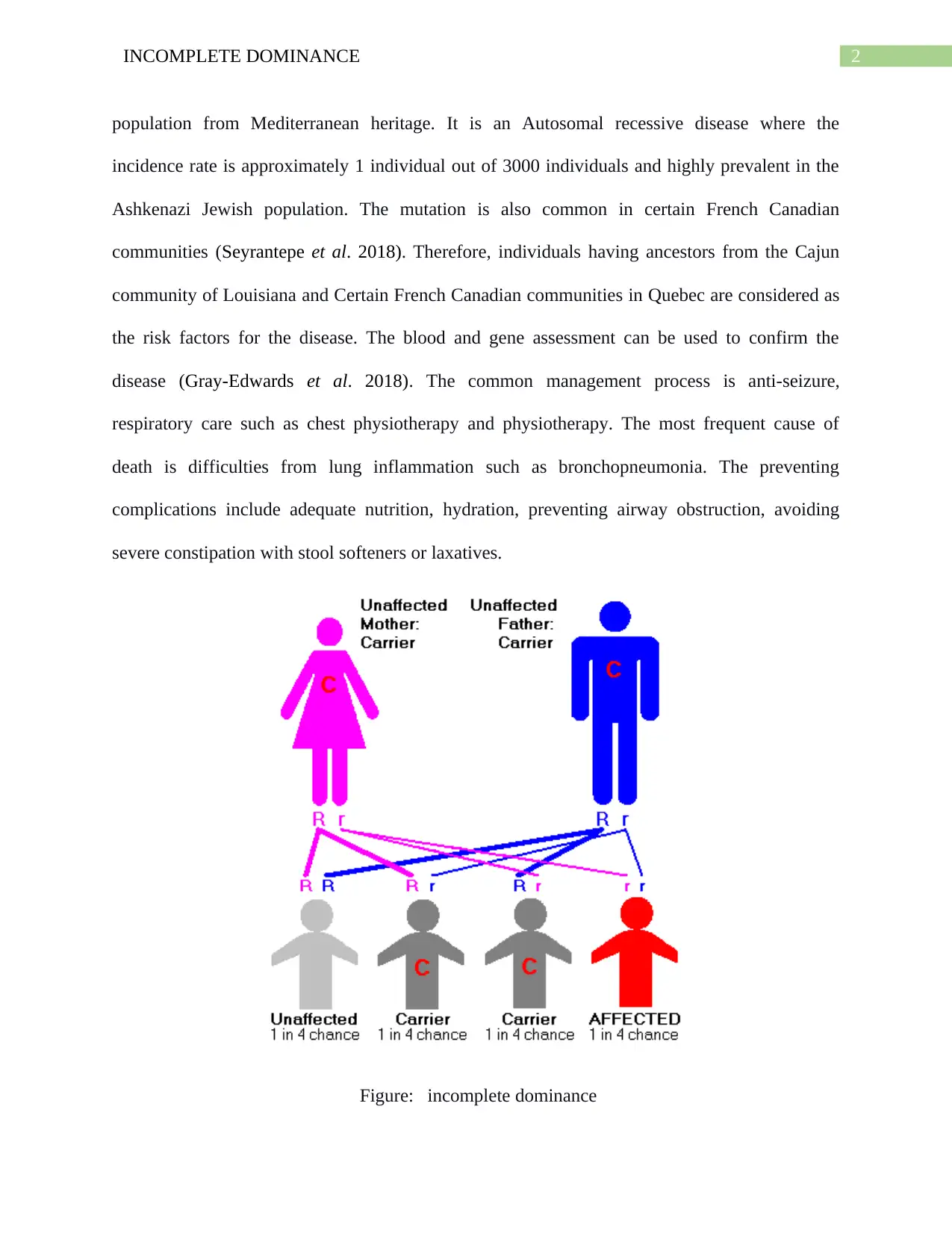
2INCOMPLETE DOMINANCE
population from Mediterranean heritage. It is an Autosomal recessive disease where the
incidence rate is approximately 1 individual out of 3000 individuals and highly prevalent in the
Ashkenazi Jewish population. The mutation is also common in certain French Canadian
communities (Seyrantepe et al. 2018). Therefore, individuals having ancestors from the Cajun
community of Louisiana and Certain French Canadian communities in Quebec are considered as
the risk factors for the disease. The blood and gene assessment can be used to confirm the
disease (Gray-Edwards et al. 2018). The common management process is anti-seizure,
respiratory care such as chest physiotherapy and physiotherapy. The most frequent cause of
death is difficulties from lung inflammation such as bronchopneumonia. The preventing
complications include adequate nutrition, hydration, preventing airway obstruction, avoiding
severe constipation with stool softeners or laxatives.
Figure: incomplete dominance
population from Mediterranean heritage. It is an Autosomal recessive disease where the
incidence rate is approximately 1 individual out of 3000 individuals and highly prevalent in the
Ashkenazi Jewish population. The mutation is also common in certain French Canadian
communities (Seyrantepe et al. 2018). Therefore, individuals having ancestors from the Cajun
community of Louisiana and Certain French Canadian communities in Quebec are considered as
the risk factors for the disease. The blood and gene assessment can be used to confirm the
disease (Gray-Edwards et al. 2018). The common management process is anti-seizure,
respiratory care such as chest physiotherapy and physiotherapy. The most frequent cause of
death is difficulties from lung inflammation such as bronchopneumonia. The preventing
complications include adequate nutrition, hydration, preventing airway obstruction, avoiding
severe constipation with stool softeners or laxatives.
Figure: incomplete dominance
⊘ This is a preview!⊘
Do you want full access?
Subscribe today to unlock all pages.

Trusted by 1+ million students worldwide
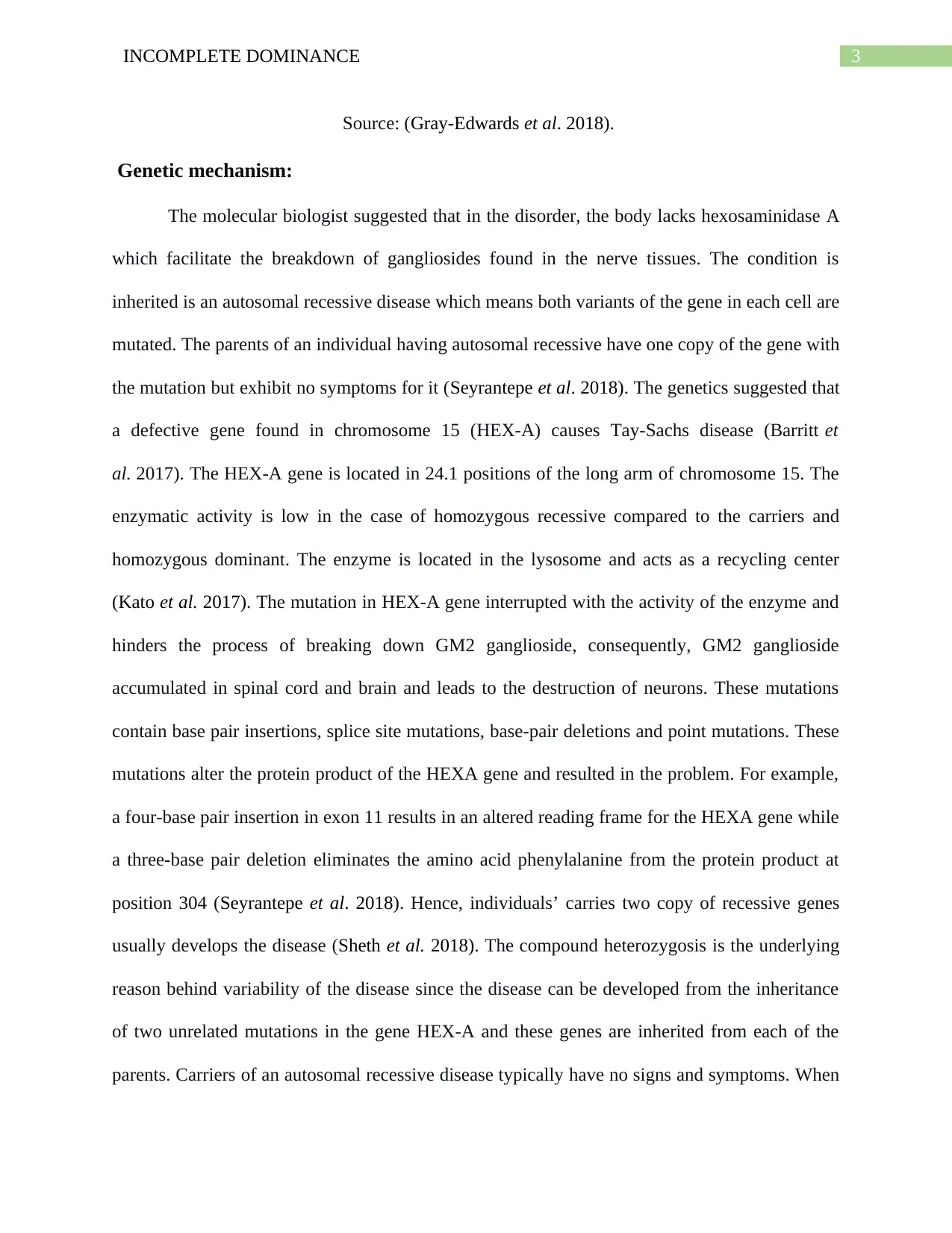
3INCOMPLETE DOMINANCE
Source: (Gray-Edwards et al. 2018).
Genetic mechanism:
The molecular biologist suggested that in the disorder, the body lacks hexosaminidase A
which facilitate the breakdown of gangliosides found in the nerve tissues. The condition is
inherited is an autosomal recessive disease which means both variants of the gene in each cell are
mutated. The parents of an individual having autosomal recessive have one copy of the gene with
the mutation but exhibit no symptoms for it (Seyrantepe et al. 2018). The genetics suggested that
a defective gene found in chromosome 15 (HEX-A) causes Tay-Sachs disease (Barritt et
al. 2017). The HEX-A gene is located in 24.1 positions of the long arm of chromosome 15. The
enzymatic activity is low in the case of homozygous recessive compared to the carriers and
homozygous dominant. The enzyme is located in the lysosome and acts as a recycling center
(Kato et al. 2017). The mutation in HEX-A gene interrupted with the activity of the enzyme and
hinders the process of breaking down GM2 ganglioside, consequently, GM2 ganglioside
accumulated in spinal cord and brain and leads to the destruction of neurons. These mutations
contain base pair insertions, splice site mutations, base-pair deletions and point mutations. These
mutations alter the protein product of the HEXA gene and resulted in the problem. For example,
a four-base pair insertion in exon 11 results in an altered reading frame for the HEXA gene while
a three-base pair deletion eliminates the amino acid phenylalanine from the protein product at
position 304 (Seyrantepe et al. 2018). Hence, individuals’ carries two copy of recessive genes
usually develops the disease (Sheth et al. 2018). The compound heterozygosis is the underlying
reason behind variability of the disease since the disease can be developed from the inheritance
of two unrelated mutations in the gene HEX-A and these genes are inherited from each of the
parents. Carriers of an autosomal recessive disease typically have no signs and symptoms. When
Source: (Gray-Edwards et al. 2018).
Genetic mechanism:
The molecular biologist suggested that in the disorder, the body lacks hexosaminidase A
which facilitate the breakdown of gangliosides found in the nerve tissues. The condition is
inherited is an autosomal recessive disease which means both variants of the gene in each cell are
mutated. The parents of an individual having autosomal recessive have one copy of the gene with
the mutation but exhibit no symptoms for it (Seyrantepe et al. 2018). The genetics suggested that
a defective gene found in chromosome 15 (HEX-A) causes Tay-Sachs disease (Barritt et
al. 2017). The HEX-A gene is located in 24.1 positions of the long arm of chromosome 15. The
enzymatic activity is low in the case of homozygous recessive compared to the carriers and
homozygous dominant. The enzyme is located in the lysosome and acts as a recycling center
(Kato et al. 2017). The mutation in HEX-A gene interrupted with the activity of the enzyme and
hinders the process of breaking down GM2 ganglioside, consequently, GM2 ganglioside
accumulated in spinal cord and brain and leads to the destruction of neurons. These mutations
contain base pair insertions, splice site mutations, base-pair deletions and point mutations. These
mutations alter the protein product of the HEXA gene and resulted in the problem. For example,
a four-base pair insertion in exon 11 results in an altered reading frame for the HEXA gene while
a three-base pair deletion eliminates the amino acid phenylalanine from the protein product at
position 304 (Seyrantepe et al. 2018). Hence, individuals’ carries two copy of recessive genes
usually develops the disease (Sheth et al. 2018). The compound heterozygosis is the underlying
reason behind variability of the disease since the disease can be developed from the inheritance
of two unrelated mutations in the gene HEX-A and these genes are inherited from each of the
parents. Carriers of an autosomal recessive disease typically have no signs and symptoms. When
Paraphrase This Document
Need a fresh take? Get an instant paraphrase of this document with our AI Paraphraser
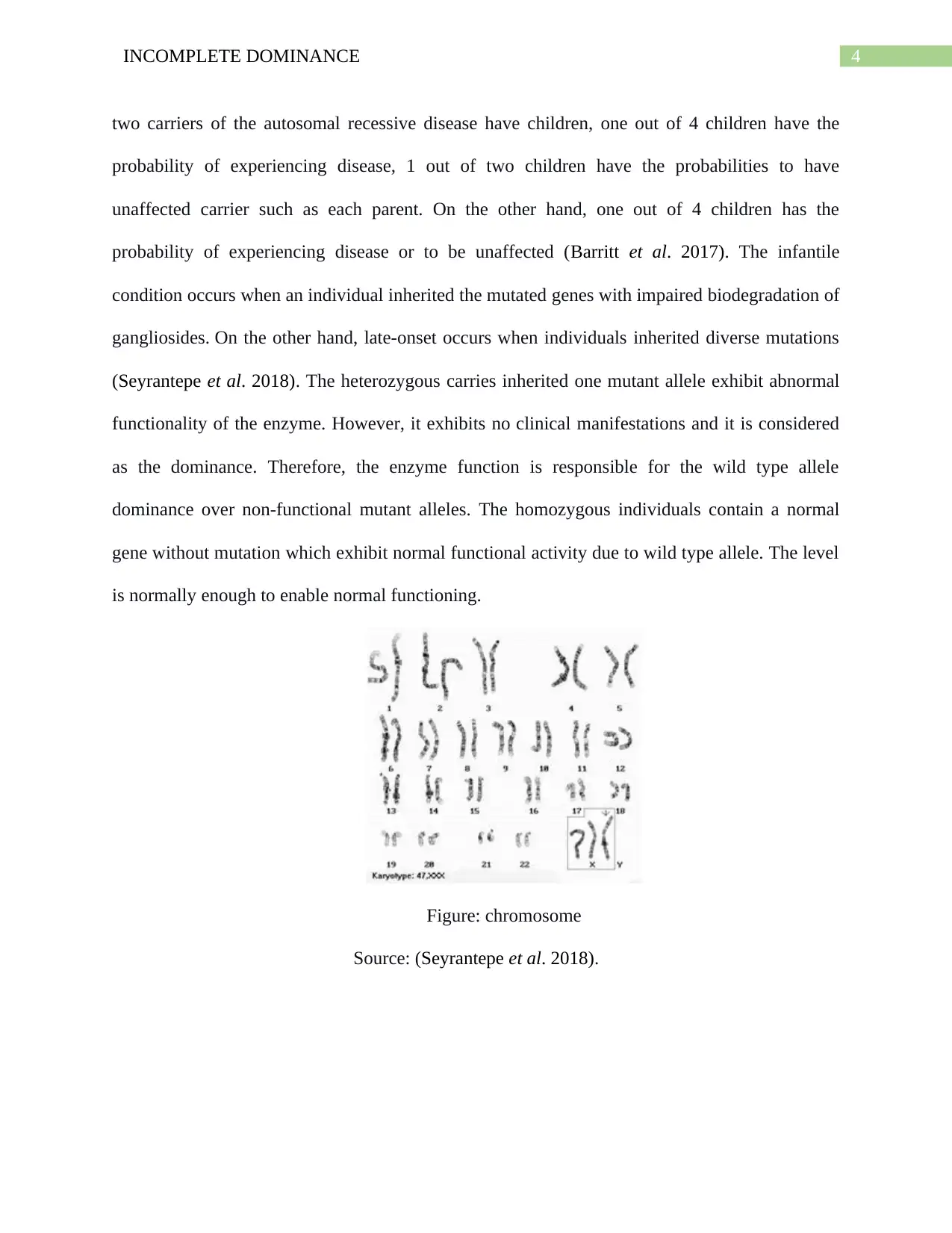
4INCOMPLETE DOMINANCE
two carriers of the autosomal recessive disease have children, one out of 4 children have the
probability of experiencing disease, 1 out of two children have the probabilities to have
unaffected carrier such as each parent. On the other hand, one out of 4 children has the
probability of experiencing disease or to be unaffected (Barritt et al. 2017). The infantile
condition occurs when an individual inherited the mutated genes with impaired biodegradation of
gangliosides. On the other hand, late-onset occurs when individuals inherited diverse mutations
(Seyrantepe et al. 2018). The heterozygous carries inherited one mutant allele exhibit abnormal
functionality of the enzyme. However, it exhibits no clinical manifestations and it is considered
as the dominance. Therefore, the enzyme function is responsible for the wild type allele
dominance over non-functional mutant alleles. The homozygous individuals contain a normal
gene without mutation which exhibit normal functional activity due to wild type allele. The level
is normally enough to enable normal functioning.
Figure: chromosome
Source: (Seyrantepe et al. 2018).
two carriers of the autosomal recessive disease have children, one out of 4 children have the
probability of experiencing disease, 1 out of two children have the probabilities to have
unaffected carrier such as each parent. On the other hand, one out of 4 children has the
probability of experiencing disease or to be unaffected (Barritt et al. 2017). The infantile
condition occurs when an individual inherited the mutated genes with impaired biodegradation of
gangliosides. On the other hand, late-onset occurs when individuals inherited diverse mutations
(Seyrantepe et al. 2018). The heterozygous carries inherited one mutant allele exhibit abnormal
functionality of the enzyme. However, it exhibits no clinical manifestations and it is considered
as the dominance. Therefore, the enzyme function is responsible for the wild type allele
dominance over non-functional mutant alleles. The homozygous individuals contain a normal
gene without mutation which exhibit normal functional activity due to wild type allele. The level
is normally enough to enable normal functioning.
Figure: chromosome
Source: (Seyrantepe et al. 2018).
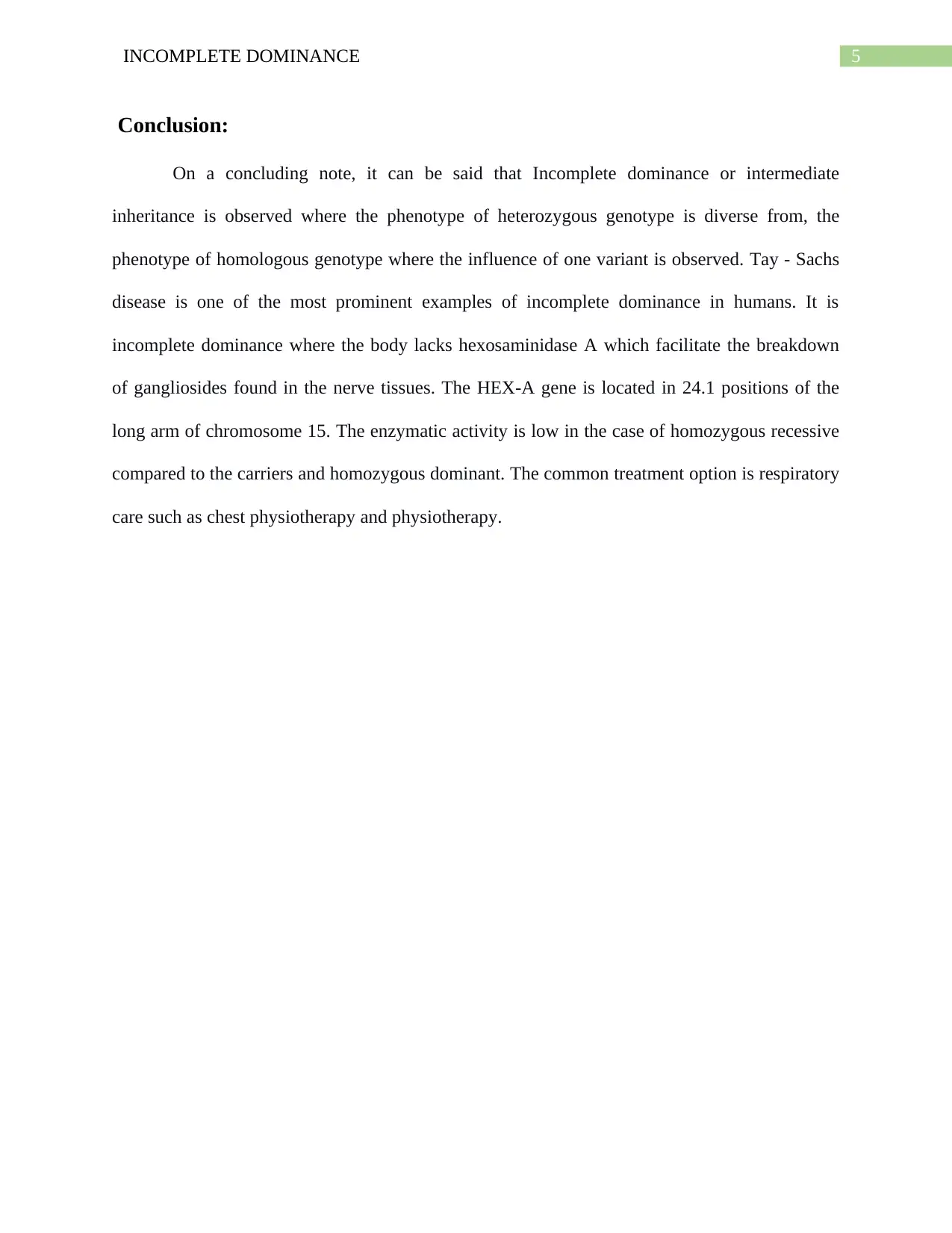
5INCOMPLETE DOMINANCE
Conclusion:
On a concluding note, it can be said that Incomplete dominance or intermediate
inheritance is observed where the phenotype of heterozygous genotype is diverse from, the
phenotype of homologous genotype where the influence of one variant is observed. Tay - Sachs
disease is one of the most prominent examples of incomplete dominance in humans. It is
incomplete dominance where the body lacks hexosaminidase A which facilitate the breakdown
of gangliosides found in the nerve tissues. The HEX-A gene is located in 24.1 positions of the
long arm of chromosome 15. The enzymatic activity is low in the case of homozygous recessive
compared to the carriers and homozygous dominant. The common treatment option is respiratory
care such as chest physiotherapy and physiotherapy.
Conclusion:
On a concluding note, it can be said that Incomplete dominance or intermediate
inheritance is observed where the phenotype of heterozygous genotype is diverse from, the
phenotype of homologous genotype where the influence of one variant is observed. Tay - Sachs
disease is one of the most prominent examples of incomplete dominance in humans. It is
incomplete dominance where the body lacks hexosaminidase A which facilitate the breakdown
of gangliosides found in the nerve tissues. The HEX-A gene is located in 24.1 positions of the
long arm of chromosome 15. The enzymatic activity is low in the case of homozygous recessive
compared to the carriers and homozygous dominant. The common treatment option is respiratory
care such as chest physiotherapy and physiotherapy.
⊘ This is a preview!⊘
Do you want full access?
Subscribe today to unlock all pages.

Trusted by 1+ million students worldwide
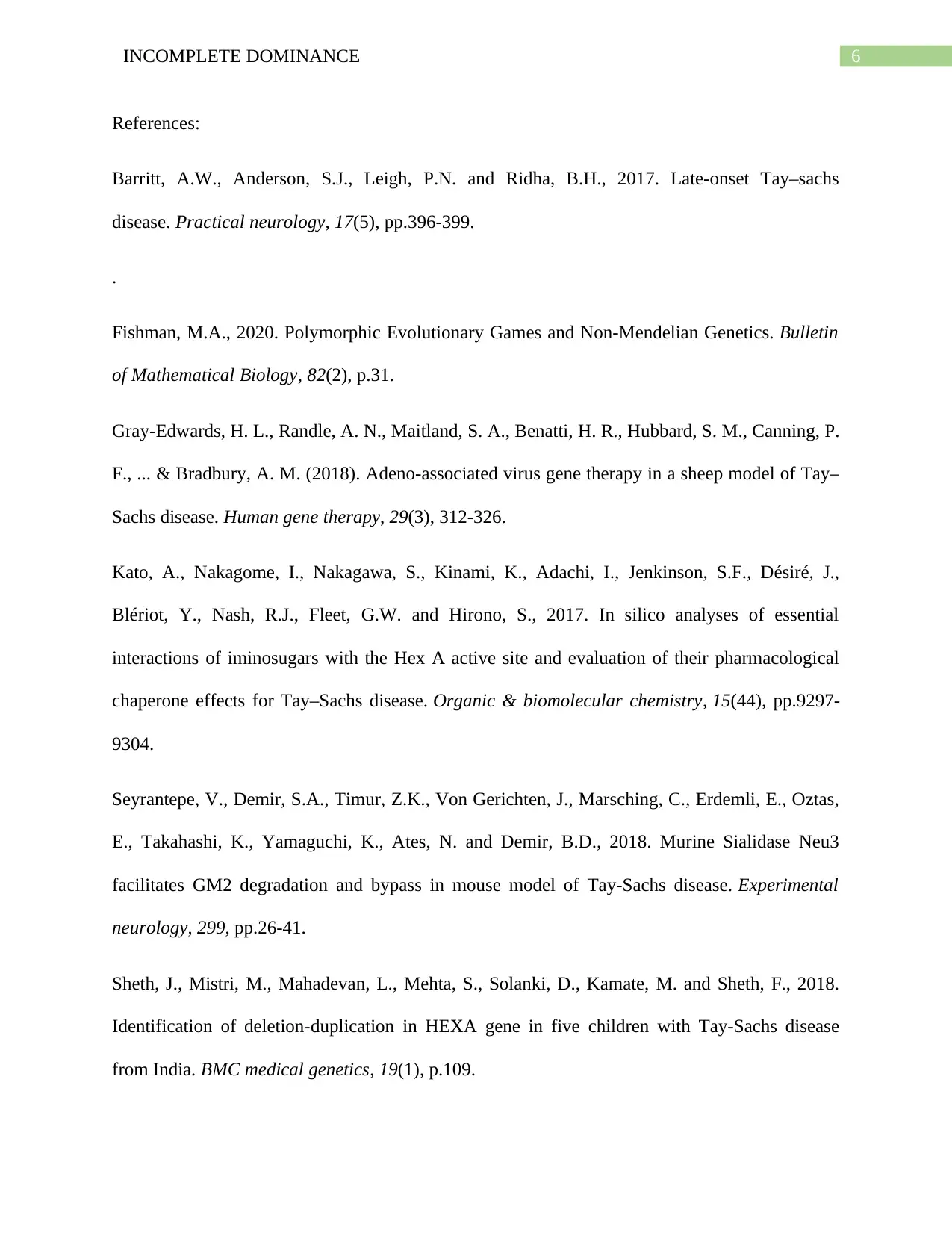
6INCOMPLETE DOMINANCE
References:
Barritt, A.W., Anderson, S.J., Leigh, P.N. and Ridha, B.H., 2017. Late-onset Tay–sachs
disease. Practical neurology, 17(5), pp.396-399.
.
Fishman, M.A., 2020. Polymorphic Evolutionary Games and Non-Mendelian Genetics. Bulletin
of Mathematical Biology, 82(2), p.31.
Gray-Edwards, H. L., Randle, A. N., Maitland, S. A., Benatti, H. R., Hubbard, S. M., Canning, P.
F., ... & Bradbury, A. M. (2018). Adeno-associated virus gene therapy in a sheep model of Tay–
Sachs disease. Human gene therapy, 29(3), 312-326.
Kato, A., Nakagome, I., Nakagawa, S., Kinami, K., Adachi, I., Jenkinson, S.F., Désiré, J.,
Blériot, Y., Nash, R.J., Fleet, G.W. and Hirono, S., 2017. In silico analyses of essential
interactions of iminosugars with the Hex A active site and evaluation of their pharmacological
chaperone effects for Tay–Sachs disease. Organic & biomolecular chemistry, 15(44), pp.9297-
9304.
Seyrantepe, V., Demir, S.A., Timur, Z.K., Von Gerichten, J., Marsching, C., Erdemli, E., Oztas,
E., Takahashi, K., Yamaguchi, K., Ates, N. and Demir, B.D., 2018. Murine Sialidase Neu3
facilitates GM2 degradation and bypass in mouse model of Tay-Sachs disease. Experimental
neurology, 299, pp.26-41.
Sheth, J., Mistri, M., Mahadevan, L., Mehta, S., Solanki, D., Kamate, M. and Sheth, F., 2018.
Identification of deletion-duplication in HEXA gene in five children with Tay-Sachs disease
from India. BMC medical genetics, 19(1), p.109.
References:
Barritt, A.W., Anderson, S.J., Leigh, P.N. and Ridha, B.H., 2017. Late-onset Tay–sachs
disease. Practical neurology, 17(5), pp.396-399.
.
Fishman, M.A., 2020. Polymorphic Evolutionary Games and Non-Mendelian Genetics. Bulletin
of Mathematical Biology, 82(2), p.31.
Gray-Edwards, H. L., Randle, A. N., Maitland, S. A., Benatti, H. R., Hubbard, S. M., Canning, P.
F., ... & Bradbury, A. M. (2018). Adeno-associated virus gene therapy in a sheep model of Tay–
Sachs disease. Human gene therapy, 29(3), 312-326.
Kato, A., Nakagome, I., Nakagawa, S., Kinami, K., Adachi, I., Jenkinson, S.F., Désiré, J.,
Blériot, Y., Nash, R.J., Fleet, G.W. and Hirono, S., 2017. In silico analyses of essential
interactions of iminosugars with the Hex A active site and evaluation of their pharmacological
chaperone effects for Tay–Sachs disease. Organic & biomolecular chemistry, 15(44), pp.9297-
9304.
Seyrantepe, V., Demir, S.A., Timur, Z.K., Von Gerichten, J., Marsching, C., Erdemli, E., Oztas,
E., Takahashi, K., Yamaguchi, K., Ates, N. and Demir, B.D., 2018. Murine Sialidase Neu3
facilitates GM2 degradation and bypass in mouse model of Tay-Sachs disease. Experimental
neurology, 299, pp.26-41.
Sheth, J., Mistri, M., Mahadevan, L., Mehta, S., Solanki, D., Kamate, M. and Sheth, F., 2018.
Identification of deletion-duplication in HEXA gene in five children with Tay-Sachs disease
from India. BMC medical genetics, 19(1), p.109.
Paraphrase This Document
Need a fresh take? Get an instant paraphrase of this document with our AI Paraphraser

7INCOMPLETE DOMINANCE
1 out of 8
Related Documents
Your All-in-One AI-Powered Toolkit for Academic Success.
+13062052269
info@desklib.com
Available 24*7 on WhatsApp / Email
![[object Object]](/_next/static/media/star-bottom.7253800d.svg)
Unlock your academic potential
Copyright © 2020–2025 A2Z Services. All Rights Reserved. Developed and managed by ZUCOL.





